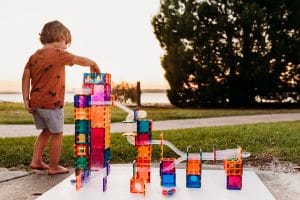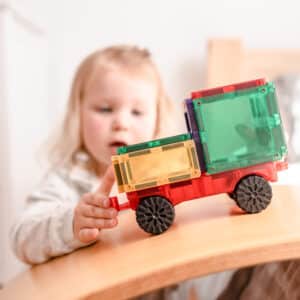Establishing gross motor skills and fine motor skills in early childhood is important as they become the foundation for physical activity in later life. However, despite its importance, physical skills development does not have to be hard work.
Physical Development Overview
What Are Gross Motor Skills?

The term gross motors skills refers to movements that involve the whole body or movements by large muscles. Gross motor skills include arm, leg, and torso movements. They form the basis of a person’s body awareness, reaction speed as well as strength and balance.
Gross motor skills are responsible for everyday movements adults rarely think about. Walking, running, kicking, throwing, and lifting are all carried out by some of the body’s largest muscles. These gross motor skills also form the basis of fine motor skills.
What Are Fine Motor Skills?
 Fine motor skills include grasping and manipulating objects. The term generally refers to using our hands and upper extremities. However, the real distinction between fine motor skills and gross motor skills relates to the muscles used for the movement. Large muscles perform gross motor skills, whilst smaller muscles are responsible for fine motor skills.
Fine motor skills include grasping and manipulating objects. The term generally refers to using our hands and upper extremities. However, the real distinction between fine motor skills and gross motor skills relates to the muscles used for the movement. Large muscles perform gross motor skills, whilst smaller muscles are responsible for fine motor skills.
Importance In Early Childhood Development
Gross motor skills, fine motor skills and visual skills are all part of physical development milestones. These milestones are general guides for parents, paediatricians, childcare professionals, and others to assess a child’s development. Developmental milestones are not set in stone. Whilst growth and development are somewhat predictable, there is a big range of what is considered normal.
Learning fine motor skills in early childhood lays the foundation for more advanced skills such as handwriting or reading music and playing an instrument. As crucial as these skills are, developing them is literally child’s play. Let’s explore some ways you can encourage physical development through Connetix play!
Connetix Play Ideas
Connetix tiles are an excellent way of stimulating fine and gross motor skill development. We recommend introducing them to children from the age of three years and up. The possibilities for play are endless.
A Simple Start

Developing fine motor skills does not have to be complicated. Sticking magnetic tiles together and pulling them apart improves finger strength, dexterity and hand-eye coordination. Let your child pick a favourite colour and set them a small challenge like making a cube shape or a pyramid.
Endless Fun With Ball Runs

Often the simplest toys are those children will play with again and again. Setting up a simple ball run does not take long and provides hours of entertainment. Apart from ‘building’ the run itself, your child practices BOTH gross and fine motor skills by placing the ball in the run and retrieving it at the end.
If you have older children, you may find the ball run becomes more and more complex and fascinating as they develop their ideas.
Refractions For Colour

Does your child have a favourite colour? Maybe they do, but when the sun hits Connetix magnetic tiles and creates magical refractions, picking only one colour is hard. Playing with magnetic tiles by a window not only lets children develop motor skills, but they also learn about changing light as the day goes on. Take it one step further by using the window as a base and building against it. It’s a perfect rainy-day idea. Building vertically will not only improve physical development but also brain development.
Reach High

Fridge play never gets old! Start a pattern on your fridge that children can finish, or perhaps a colour/shape sorting challenge. As well as the opportunity for exploring colours and shapes, using Connetix on a fridge or whiteboard is a simple way to set up vertical play opportunities. Vertical play is a great way to work on many different skills. It increases core strength, works on shoulder stability, helps develop spatial awareness, and engages bilateral coordination (i.e. having both sides of the brain working at the same time!).
How About Hopscotch? or An Obstacle Course?

Fancy combining gross and fine motor skills? How about setting up a hopscotch course with tiles on your floor? Flat tiles are perfect for creating hopscotch square boundaries, and adding some 3D obstacles to jump over makes for a fantastic afternoon of activity. You can also create an obstacle course by setting up a variety of Connetix obstacles in a track – from 3D cubes and pyramids to jump over and lines to follow. Please note: we do not recommend jumping or standing directly on your Connetix.
Life’s A Maze!

As a parent of a small child, you’re forgiven for feeling like life is a maze sometimes. Rather than letting that overwhelm you, build your own colourful Connetix maze. Our baseplates are the perfect foundation, and you can use your imagination when it comes to setting up the walls. Add a ball and encourage your child to balance the maze to move the ball. Just like ball runs, mazes can be endlessly entertaining.
Developing gross and fine motor skills is a crucial part of any child’s physical development. It is also a lot of fun when you find ways to incorporate it into playtime. Connetix magnetic tiles combine creativity, hand-eye coordination and physical development in a playful way. Give it a try today!

